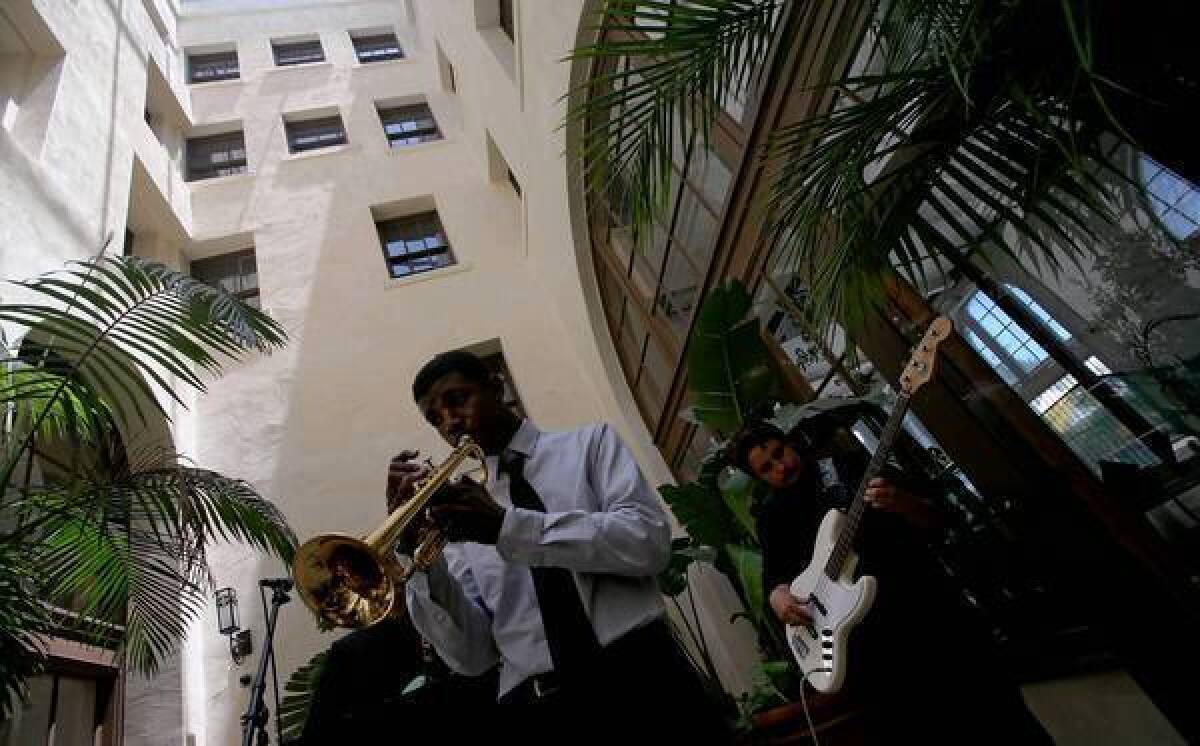Jazz patrons see L.A.’s Central Avenue on the upswing

- Share via
Slowly, steadily, in the shadow of downtown Los Angeles, change is coming to the history-rich but long beleaguered heart of Central Avenue.
Crime is down and optimism up. There’s a new cafe, a new grocery store, new shops and apartment buildings. On 42nd Street there’s the Dunbar Hotel — a showpiece during the area’s heyday as a jazz mecca — which reopened this summer as senior housing after a painstaking restoration.
A sense that the neighborhood is on the mend could be felt Saturday on the streets surrounding the Dunbar, where an energetic crowd of about 2,500 convened for the 18th annual Central Avenue Jazz Festival.
“This is a celebration of black L.A. and L.A.’s jazz history,” said Mark Wilson, executive director of the Coalition for Responsible Community Development, organizer of the event, which culminates with Sunday night’s show by Gilbert Castellanos and the New Latin Jazz Quintet. “But it’s more than that. It’s also a celebration of the entire city’s cultural heritage and a sign that things are changing. People are willing to invest in Central Avenue again.”
Wilson scanned the avenue and smiled. A colorful, multiethnic crowd milled around, eating tacos or barbecue or fried fish, meandering near homespun booths selling candles or baseball caps or pastel paintings of President Obama. A large canopy covered onlookers as they listened to a band ease through some of the same tunes that echoed through the district during its pre-civil rights era heyday, when such jazz greats as Dexter Gordon and Charles Mingus were regulars at the Dunbar Hotel, partly because of the city’s segregation.
For years the festival was a much smaller and less dynamic affair. “It only had 200 seats — pretty cramped,” said Wilson, recalling a decade ago, when the event was held at a tiny park across from the Dunbar, which at the time was seedy and crime-strewn. He noted that as the neighborhood started improving, the festival improved as well: In front of the stage Saturday was seating for 1,500 people. On sidewalks, scores of onlookers took in the music, standing, or sitting in folding chairs.
“It’s a real menagerie here,” said one of the crowd, Ted Jones, 79, who began coming to the jazz district in the 1950s, about the time the neighborhood began to lose its luster. Jones noted his age with pride and pointed out that he was hardly alone, since an older crowd made up a large portion of the audience. “The older folks, they can remember what it was like here back in the day, so they come to remember, like a touchstone.”
He looked at the stage and tugged his Dallas Cowboys baseball cap. A high school jazz group was swaying and swinging, fronted by a girl who sang with sass, her voice echoing down the block, recalling Ella Fitzgerald. “Wow,” said Jones. “We look up and see the younger generation playing, young kids playing jazz, loving it, in this community, and there is light at the end of the tunnel, and that light is a bright light.”
Twitter: @kurtstreeter
More to Read
Sign up for Essential California
The most important California stories and recommendations in your inbox every morning.
You may occasionally receive promotional content from the Los Angeles Times.














